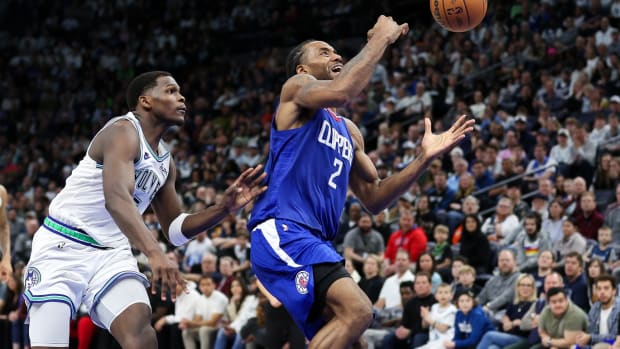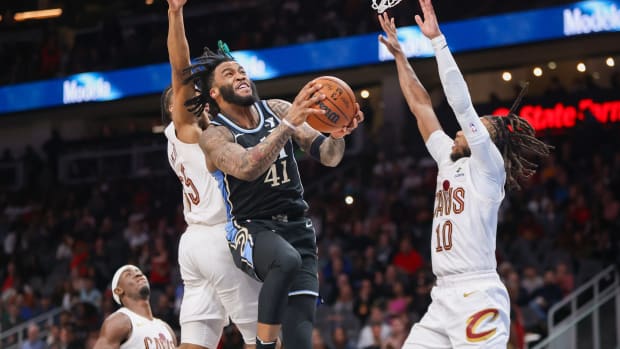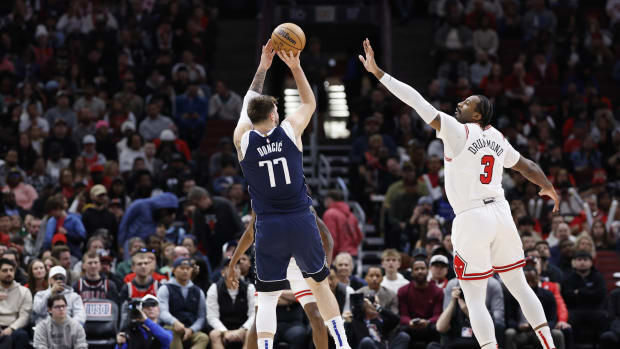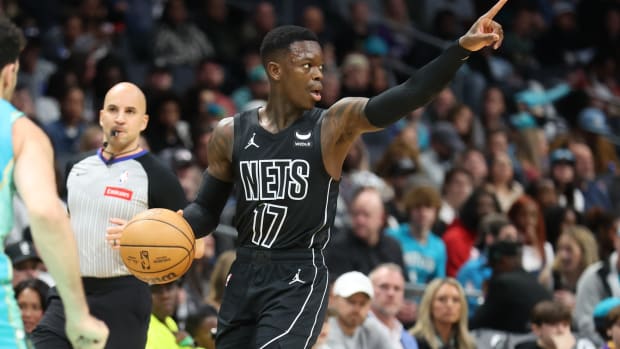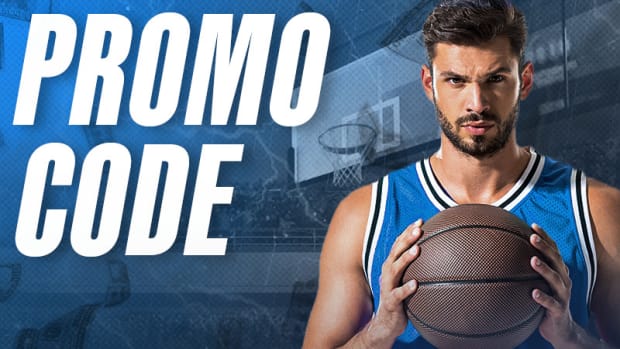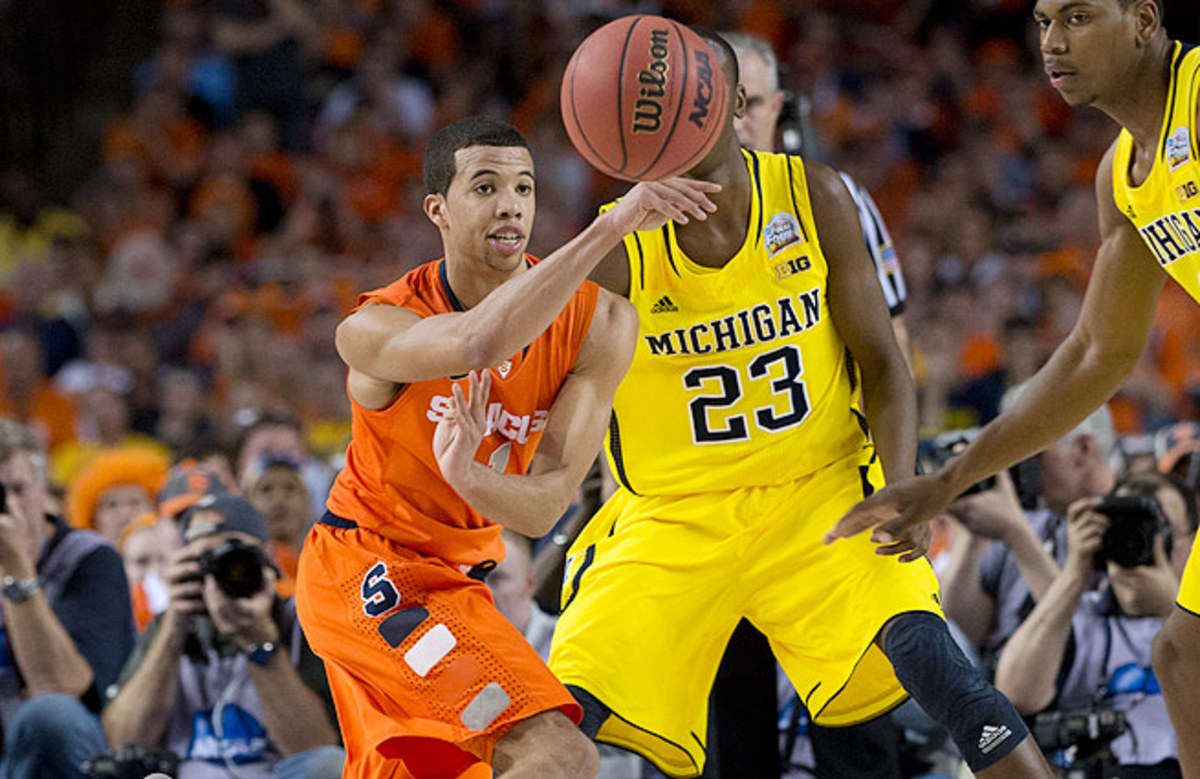
NBA draft 2013 superlatives: Best playmaker, most star potential, more
Which player in the 2013 draft class has the most star potential? Who's poised to be the biggest bust? With the NBA draft fast approaching, Chris Mannix hands out some superlatives.
Best Playmaker: Michael Carter-Williams, Syracuse
The smooth, lanky Carter-Williams won't be the first point guard off the board --Michigan's Trey Burke figures to go higher -- but Carter-Williams' playmaking instincts are second to none. The Syracuse sophomore was a double-double machine the first two months of the season and finished the year averaging 11.9 points and 7.3 assists. Carter-Williams can be sloppy with the ball (3.4 turnovers per game) and his high dribble must be tightened up, but the vision and skills in the open floor are undeniable.
"He sees the floor better than any point guard in the draft," said a Western Conference exec. "He needs to develop a jump shot to keep defenses honest, but if he does he is going to be tough to cover."
MANNIX: Mock Draft 2.0 | Top international players in draft
Best Shooter: Ben McLemore, Kansas
During one season at Kansas, McLemore proved he could shoot, connecting on 42 percent of his three-point attempts. But what has NBA scouts drooling are the near flawless mechanics that remind many of Ray Allen.
"That form is so smooth," said an Eastern Conference exec. "Whatever team gets him is going to run him off screens all game, just like Allen."
McLemore should get more open looks than Allen because he isn't just a shooter. A superior athlete, McLemore excels at attacking the rim. He attempted 3.7 free throw attempts per game last season, knocking down 87 percent of his attempts. With defenders having to respect his penetration, McLemore will create more air space for his shots.
Best Defender: Nerlens Noel, Kentucky
Offensively, Noel is a work in progress. Defensively, he's a menace. Noel is an uber active 7-footer with a 7-4 wingspan who plays with endless energy every possession and has the foot speed to defend both power positions. During a brief, 24-game stint at Kentucky -- interrupted by an ACL injury that will keep him out of action until Christmas -- Noel showed an ability to cover enormous amounts of ground in the paint, making him a constant presence as a weak -side shot blocker. His individual defense needs some work, but Noel has the physical tools to develop into a Ben Wallace-type stopper.
GLOCKNER: Oladipo just a defender? | Is Bennett a tweener? | Can Burke overcome height?
Most Intriguing: Ricky Ledo, Providence
The book on Ledo is ... well, there isn't much of a book on Ledo, who didn't play for Providence last season due to academic issues. At 6-foot-6, 197-pounds, Ledo has prototypical 2-guard size with the range to be a dangerous perimeter scorer and the athleticism to finish above the rim. He's a streaky shooter who has shown a knack for creating his own shot, and some scouts believe with a little muscle and a lot of work Ledo can use that frame to play with his back to the basket.
But Ledo isn't much of a defender and his problems at Providence and in high school -- he attended four in five years, reportedly due to academic issues -- raise some maturity flags. It's as easy to see Ledo sticking to a roster and developing into a consistent role player as it is to see him flaming out of the league in a matter of months.
Best Second-Round Sleeper: Mike Muscala, Bucknell
What Muscala lacks in strength and athleticism he makes up for with a high skill level. Muscala swept the Patriot League awards last season, becoming the first player to win Player of the Year, Defensive Player of the Year and Scholar-Athlete of the Year honors, and led the league in scoring, rebounding and blocks. Muscala can knock down the perimeter jumper and score inside with both hands while shooting better than 80 percent from the free throw line. There is some serious talent in an admittedly skinny frame.
Biggest Bust Potential: Victor Oladipo, Indiana
Oladipo is a superior athlete and defender who added a consistent jump shot to his repertoire last season and is considered a high character guy. But the fact that he was a liability from beyond the three-point line his first two seasons at Indiana is an oft-echoed concern, along with Oladipo's slight frame. Could Oladipo come off a bench next season, defend multiple positions and score in transition? Probably. But to some scouts there is an equal possibility that Oladipo will be overwhelmed by physical 2-guards and that when faced with longer, more athletic defenders his jump shot won't be as consistent as it was last season.
Biggest Superstar Potential: Anthony Bennett, UNLV
Bennett is scary talented. He was primarily a post player at UNLV, but several scouts believe an NBA coach will bring out his diverse offensive skills, including some explosive moves off the dribble and a soft touch from beyond the three-point line.
"I think he is the best pure talent in the draft," said an Eastern Conference GM. "Every time I watch him play I see something new he can do."
The biggest concern about Bennett is his position. Some executives feel he can play small forward while others doubt he has the quickness defensively. Either way, there is a dynamic talent inside Bennett just waiting to come out.
Most Likely To Regret Entering The Draft: Phil Pressey, Missouri; Archie Goodwin, Kentucky (tie)
Pressey was unimpressive at the draft combine and then watched as fellow playmaker Pierre Jackson stole the show during a widely attended group workout in New Jersey. His decision to leave Missouri after an erratic junior season was a head-scratcher; he's an undersized scoring point guard that hasn't shown he is capable of being a playmaker at the next level.
Goodwin left Kentucky for a reason: UK's talented freshman class, led by the backcourt tandem of Andrew and Aaron Harrison, likely would have gobbled up a chunk of his minutes. Goodwin is athletic, can conceivably play multiple positions and can create his own shot. But he couldn't buy a jump shot at the combine, which, coupled with his 26.6 percent three-point percentage at Kentucky last season, is a major red flag.
Most Likely To Get A General Manager Fired: Rudy Gobert, France
Ask any GM what they like about Gobert and the answers will all be the same: His length. Gobert is 7-foot-2 with a 7-9 wingspan, appealing measurements for a rim protector.
Ask for another positive attribute, and the answers get a little vague. Gobert can't shoot, has shown no polished post moves in workouts and isn't particularly athletic. He runs the floor well but his lack of strength -- particularly in the lower body -- is troubling.
Ideally, a team in the back-half of the first round drafts Gobert, stashes him overseas on a high-level European team and brings him back in a year or two when his skills have had a chance to develop. But if Gobert goes in the lottery and is expected to contribute quickly, well, buyer beware
Biggest Risk/Reward: Tony Mitchell
Sure, Mitchell is a bit delusional: At the combine he compared himself to Kenneth Faried, while acknowledging to teams that Faried played hard all the time and that at North Texas, he didn't. But Mitchell is a physical specimen who has enough talent that several executives spoke of him as a top-10 pick before the season. You can't teach heart, and if Mitchell doesn't have it, he won't be much of a factor. But if he can ever harness his talent and athleticism, there's a 10-year starting power forward in that body.































